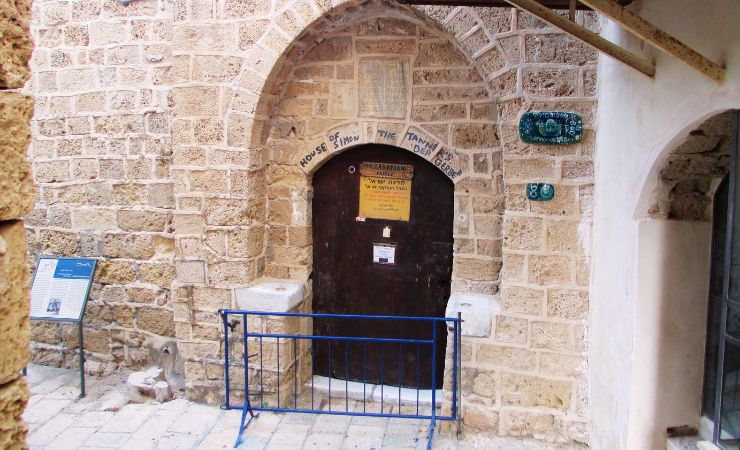A Vision on the Roof: The House of Simon the Tanner
In the heart of Jaffa, Simon the Tanner’s house invites travelers to explore its deep roots in Christian tradition. On the house’s rooftop, Peter understood that God’s plan of salvation was for all people – Jews and Gentiles alike.

Simon the Tanner's House Location: A Blend of Sea and Spirituality
Though the original structure no longer stands, visitors can see the traditional location where one of the most pivotal events in the New Testament took place.
Biblical Context
The house of Simon the Tanner holds a pivotal place in Christian heritage due to the transformative vision of the Apostle Peter. Up on the roof, in Simon the Tanner’s House, Peter saw a large sheet being let down from heaven, containing all kinds of four-footed animals, reptiles and birds. A voice told Peter to “kill and eat”.
The vision symbolizes God’s message not to consider any person impure or unclean. This vision led to the inclusion of Gentiles into the early Christian community.
About noon the following day as they were on their journey and approaching the city, Peter went up on the roof to pray. He became hungry and wanted something to eat, and while the meal was being prepared, he fell into a trance. He saw heaven opened and something like a large sheet being let down to earth by its four corners. It contained all kinds of four-footed animals, as well as reptiles and birds. Then a voice told him, ‘Get up, Peter. Kill and eat.’ ‘Surely not, Lord!’ Peter replied. ‘I have never eaten anything impure or unclean.’ The voice spoke to him a second time, ‘Do not call anything impure that God has made clean.’ This happened three times, and immediately the sheet was taken back to heaven.
The events that unfolded at Simon the Tanner’s house marks a significant departure from Jewish dietary laws and traditions.

The Current House
The house currently owned by an Armenian family for generations is claimed to be the site of Simon the Tanner’s residence. However, it cannot be confirmed if this tradition genuinely links all the way back to New Testament times. The family keeps the site private with no option for tourists to enter or archaeologists to study any physical evidence within. Gazing at the simple stone walls from outside, it is felt it almost fitting for a humble tanner’s dwelling to maintain an air of quiet mystery.
The tradition that Simon the Tanner’s house is located in the current site in Jaffa is deeply rooted in several factors tied to the biblical narrative, historical associations, and long-standing beliefs:
Biblical Description: The Acts of the Apostles describes Simon the Tanner’s house as being “by the sea” (Acts 10:6). The traditional site is situated on a hill in Jaffa, overlooking the Mediterranean Sea, fitting the biblical description’s geographical specifics. This proximity to the sea aligns with ancient practices, as tanners required access to large amounts of water for their work, further supporting the tradition of this location.
Historical Continuity: The house’s tradition in Jaffa is supported by centuries of Christian pilgrimage and veneration. Over time, specific locations become associated with biblical events through the collective memory of communities and the practices of pilgrims visiting these sites. This continuity of reverence and identification helps solidify the tradition of Simon the Tanner’s house being in this particular location.
Cultural and Religious Significance: Jaffa itself is one of the oldest port cities in the world, with a rich history that intersects with various cultures and religions. Its significance in both Christian and Jewish traditions as a site of miracles and biblical events lends weight to the tradition of important biblical figures like Simon the Tanner and Peter having lived and experienced divine revelations here.
Community and Family Tradition: The claim by the Armenian family that their property in Jaffa is the site of Simon the Tanner’s house adds a layer of personal and communal tradition to the location. Though not archaeologically verified, such family and community traditions play a crucial role in maintaining the site’s historical narrative through generations.
Artistic and Literary References: Over the centuries, artistic and literary works have depicted scenes from the life of Simon the Tanner and Peter’s vision in Jaffa, further embedding the location in the collective religious and cultural consciousness as the backdrop for these significant events.
Nearby Sites
- St. Peter’s Church: Close to Simon the Tanner’s House, this church is a significant landmark in Jaffa, commemorating the apostle Peter’s vision.
- The Andromeda Rock: This natural feature is linked to the myth of Andromeda.
St. Nicholas Monastery: This Armenian monastery is a complex that includes an Armenian church and living quarters. It is where Napoleon Bonaparte and his soldiers stayed during their campaign in the city in the late 18th century. .
The Clock Tower: The Clock Tower was built in the early 20th century to mark the silver jubilee of Ottoman Sultan Abdul Hamid II and to celebrate Jaffa’s modernization.



